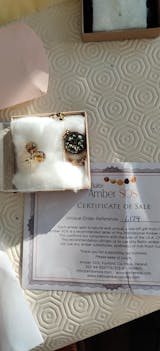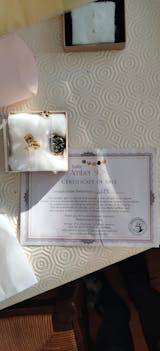About Hazelwood
What is Hazelwood?
What is Hazelwood good for?
Hazelwood comes from a shrub, grown extensively. The latin name is Corulus cornuta, common name is beaked hazel. It is like our native hazel Corylus Avellana.
Why use Hazelwood?
It is not a medicine as such, but a natural healing product first used by the Native tribes of America. Hazelwood is rich is polyphenols, molecules known for their antioxidant, antibacterial and anti-inflammatory effect. It may help to ease the symptoms related to inflammation and acidity in the body such as heartburn and reflux, skin problems such as psoriasis, eczema and acne, joint pain, mouth ulcers and more.
How does Hazelwood work?
In contact with the skin, hazelwood acts like a patch, releasing its molecules. Wearers notice a reduction in the outward symptoms of their inflammation. It is not a cure for any problem, but can ease the inflammatory symptoms.
Which is best – a Hazelwood Necklace or Bracelet?
See our Hazelwood Necklace for Children
See our Hazelwood Anklet for Children
There is no difference between the two products in terms of efficiency. But experience shows that it is the area of hazel wood in contact with the skin that matters. Ideally, for serious situations, we suggest wearing both the necklace and bracelet: that way, if you decide not to wear the necklace for a day, you will still benefit from the bracelet.
Indeed, some people choose to wear the bracelet or anklet rather than the necklace for reasons of appearance or discretion, but they still get the hazel wood benefits. If you choose to wear only the bracelet, you could wear the double bracelet which is made of about as much hazel wood as the necklace.
When should I replace my Hazelwood Jewellery?
For best results, we highly recommend replacing the necklace and/or the bracelet after about 3 to 6 months. This period may vary from one person to another, depending on the severity of symptoms. Customers generally rely on either one of the following signs to evaluate when they need to get a new necklace or bracelet. First, the extremities of the wood beads will tend to get darker with normal use, showing that the product have reached its full potential. Second, the symptoms slowly returning are also a reminder.
Shop our Hazelwood Jewellery Collection - Coming Soon
Is it normal to lose piece of bark?
Since we use only 100% natural hazel wood (no varnish is applied), we cannot control all the mechanical properties of the wood and its responses to various external factors to which it is submitted (friction with clothes, bath etc.) Sometimes, the bark splits and partially falls. Users testify that our eco-friendly hazelwood products still retain their properties.
Can I wear my hazelwood jewelry in the bath or shower?
Hazel wood is highly resistant to clear water. You can keep the jewelry in the shower; that prevents you from forgetting to put it back on afterwards. However, we strongly suggest removing your necklace or bracelet if you go in a pool or hot tub. Chemicals such as chlorine can damage the hazel wood.
Are the clasps nickel free?
Our screw clasps are made of stainless steel and our lobster clasps are made of zinc, and both may contain nickel. If you know that you could react to these metals, you can put a few coats of clear nail polish on the clasp or cover it with a small piece of tape.
Can I wear hazelwood if I have a nut allergy?
Most nut allergies are food allergies i.e. ingested orally. It means consumption of products that contain these nuts i.e. the fruit of the tree, not the wood. Our hazelwood partners follow rigorous eco-friendly methods to ensure that the hazel branches do not touch the nuts at any time. Also, each nut is covered with a thick and rigid hull, making it impossible to get in direct contact with the branches. However, you should seek advice from your allergy specialist.




